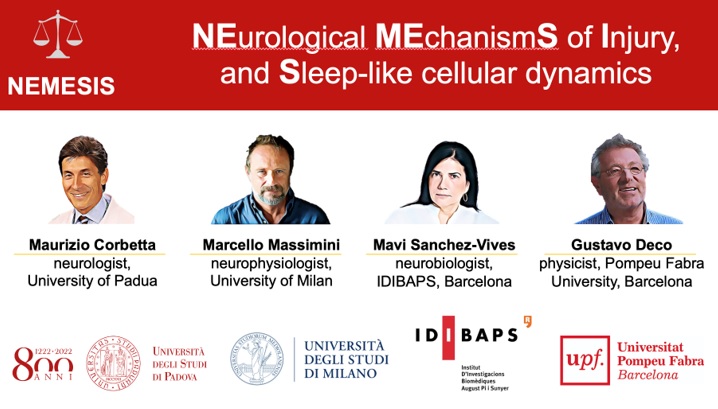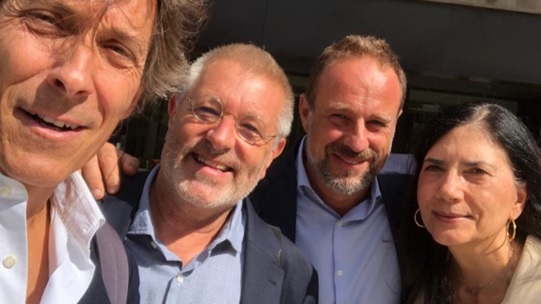The NEMESIS project, a new weapon for the treatment of focal brain lesions, receives an ERC Synergy Grant
The NEMESIS project, a new weapon for the treatment of focal brain lesions, receives an ERC Synergy Grant
The NEMESIS project, a new weapon for the treatment of focal brain lesions, receives an ERC Synergy Grant
The team of Gustavo Deco at UPF, together with IDIBAPS and the universities of Padua and Milan in Italy, have been selected for the European Research Council (ERC) Synergy Grants programme. The grant awards 10 million euros to the four teams over the next six years. This is the first time that UPF has received this type of grant for a research project.

Focal brain lesions, such as cerebral infarction, stroke, epilepsy, trauma, etc., are the final causes of a productivity loss in Europe of close to €500 billion per year. Cerebral infarction is the second cause of death in the Union and the first cause of disability, since 60% of the million cases per year have some kind of incapacitating effect.
In addition to clinical symptoms such as total paralysis or memory loss, aphasia, fatigue, and decreased attention span, scientific evidence has revealed that most neurological and psychiatric disorders also reflect abnormalities in brain networks. This opens up a new avenue of study to treat such diseases more effectively.
The consortium has just been chosen by the European Research Council for its most prestigious program, Synergy Grants, which finances the work of the four universities for the next 6 years with 10 million euros. These grants are intended for those investigations too large to be carried out by a single researcher. It is the first time that the UPF has obtained this grant from the ERC.
Researchers at Pompeu Fabra University and IDIBAPS in Barcelona, and the universities of Padua and Milan in Italy, have devised the project “NEMESIS: NEurological MEchanismS of Injury and Sleep-like cellular dynamics” that pools years of complementary research between them and could so far only be applied jointly to experiment this treatment pathway. The consortium has just been chosen by the European Research Council (ERC) for its most prestigious programme, the Synergy Grants, to fund the work of the four universities with 10 million euros over the next six years. Synergy Grants are designed for investigations that are too large to be carried out by a single researcher (they can be apply for by between two and four teams). This is the first time UPF has obtained this type of grant from the ERC.
Nowadays the most used treatment is stimulation with circuits to improve brain functions. But this technique presents several limiting factors, such as the lack of knowledge of the underlying mechanisms and their relevance in patient behaviour, the inability to individually map these anomalies, in order to find out where and how to stimulate the brain and recover brain function.
“Only now can we undertake this project that brings together both the precise specialities and the experience with patients, with laboratory and in silico models”, explains Gustavo Deco, project coordinator at UPF, director of the Computational Neuroscience Research Group at the Center for Brain and Cognition (CBC) and ICREA researcher.
In addition to producing the effects already known, focal lesions generate slow sleep waves, that are in the range of 1Hz and 4Hz, which normally occur when sleeping. The existence of these waves when awake, even if they do not appear en masse, cause noise and disturb cognition. “On the one hand the ERC’s Synergy Grant is rewarding this discovery, that the disease is entirely related with slow sleep waves, and on the other, the fact that we researchers cover all the necessary areas to check whether acting on the dynamics of these waves can help recover the functions that patients have lost”, Deco continues.
The NEMESIS team

NEMESIS, from the Greek “give what is due”, aims to return some of the lost functionality to neurons, and will do so by characterizing the effects of the focal lesion on multiple spatial and temporal scales (from the entire brain to local circuits).
The group of Maurizio Corbetta, a professor of Neurology at the University of Padua, will be coordinating NEMESIS. Five years ago, Corbetta and his team, specialists in neuroimaging, discovered that even small injuries, such as stroke, can cause alterations in about 20% of brain networks, and that, over time, the normalization of this anomaly allowed recovering functions.
The team of Marcello Massimini, a professor of Human Physiology at the University of Milan, with its work in human electrophysiology, also documented a few years ago the presence of slow sleep waves in cases of traumatic coma, in apparently normal brain areas. More recently it observed the same thing in cases of focal lesions. This network dysfunction may be due to the generation of slow sleep waves near the lesion and their propagation.
On this side of the Mediterranean, the director of the Neuroscience group of the August Pi i Sunyer Biomedical Research Institute (IDIBAPS), Mavi Sanchez-Vives, has been working in neurobiology and models on slow sleep waves for more than 20 years, contributing knowledge on how to neutralize them. Her group will explore these waves on different scales, from cell to whole-brain level to study their mechanism and learn how to modulate them through external stimulation.
Finally is Gustavo Deco’s expert group in computer modelling. “The wave not only affects the point where it is produced, but when propagated it creates a shock wave”, he explains. “To attack them we need a standard model that can link the anatomy with healthy local dynamics and can explain the overall picture. If we “damage” the model at will, the dead neurons and the slow sleep waves that appear will generate a map of what is happening and what is spreading. And here, in silico and individually, we can test which place to touch to get the greatest benefit, or for it at least to be as close as possible to normal”.
Second ERC for Gustavo Deco
This is the second time that the ERC has awarded a grant to Gustavo Deco’s group, which is something that very few researchers achieve. The first was an Advance Grant in 2011 for the project "DYSTRUCTURE: The Dynamical and Structural Basis of Human Mind Complexity: Segregation and Integration of Information and Processing in the Brain”.
The ERC was created in 2007 and since then its grants have funded more than 12,000 projects and more than 10,000 researchers. The grants are highly competitive and only 12% of applications receive funding.
